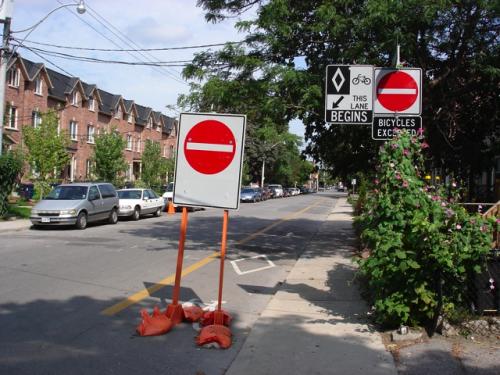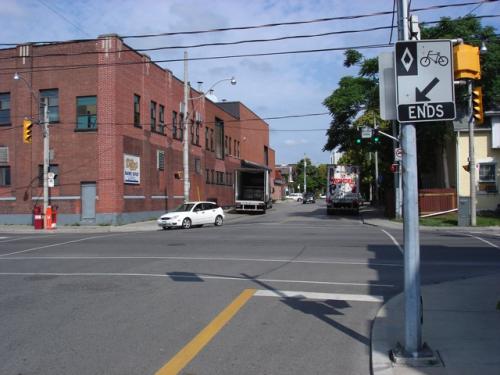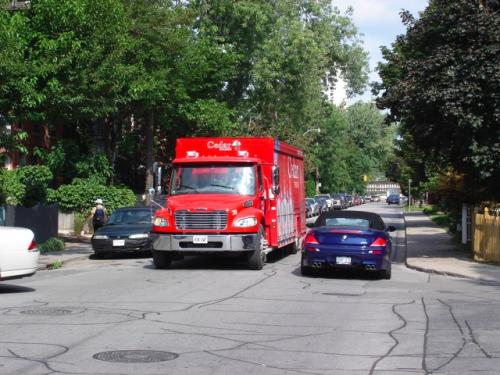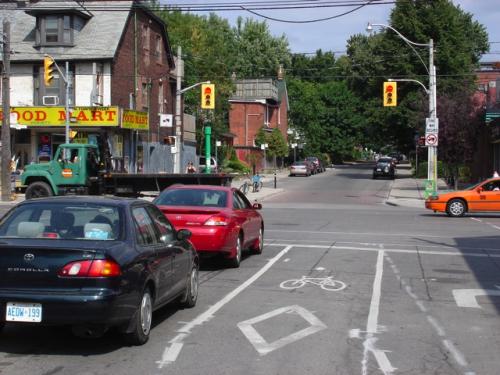 Logan Bikeway At DundasCulled from comments to a recent ibiketo.ca thread:
Logan Bikeway At DundasCulled from comments to a recent ibiketo.ca thread:
I just got back from the Logan Avenue bike lane opening, and I am impressed! -- Donald
I just got back from the Logan Avenue bike lane opening. I'm not impressed. -- Kevin Love.
That some paint splashed on asphalt can elicit such ambivalence is, well, impressive. It attests to how varied are individual standards and expectations. The lane in question was recently installed on a 400 meter stretch of Logan Ave. between Dundas Avenue and Gerrard Street. It is a segment of the proposed Logan Ave. bikeway (The Toronto Bike Plan Route T33, mislabelled as Carlaw) that will presumably connect the Martin Goodman Trail (MGT) with the Cosburn Ave. bikeway.
Riding this route often leaves me conflicted as well. The two kilometer stretch of Logan between the MGT and Danforth now has three separate bikeways -- now you see them, now you don't! -- totalling less than a kilometer. By turns they evoke appreciation, indifference, and cynicism.
Follow me up Logan, from the MGT to Danforth Ave., and decide yourself how effective are the lanes and how politics and priorities figure in their disappearing and reappearing act.
 Contraflow Lane (Logan South of Eastern)Exiting the MGT onto Logan Ave. deposits you in a nondescript industrial park. The Eastern Ave. intersection is about 300 meters north and midway there Logan transitions into a one way street southbound. A contraflow bike lane begins at this point and ends all of 100 meters north at Eastern. (Is the temporary one way street sign still planted there?)
Contraflow Lane (Logan South of Eastern)Exiting the MGT onto Logan Ave. deposits you in a nondescript industrial park. The Eastern Ave. intersection is about 300 meters north and midway there Logan transitions into a one way street southbound. A contraflow bike lane begins at this point and ends all of 100 meters north at Eastern. (Is the temporary one way street sign still planted there?)
As short as it is the lane makes sense. It facilitates bicycle through traffic on a route that simultaneously restricts autos and (significantly) trucks. The stub is a deliberate feature, not an incidental accessory, of a larger plan.
 Weston's Bakery (Logan and Eastern)
Weston's Bakery (Logan and Eastern)
North of Eastern Logan sheds the bikeway and becomes bidirectional. Weston's Bakery (right at Eastern and Logan) takes up half the block to Queen; its loading docks face Logan where there's a steady stream of 18 wheelers converging, turning, and backing in. Space is extremely tight: protective bollards are installed on the sidewalk a few feet from the doorways of the row houses directly opposite the docks.
A bikeway here is incompatible. Without a segregated facility for which there's no space (short of co-opting the sidewalk), it would direct cyclists toward heavy trucks. A reliable gauge of the adequacy of bike lane is whether a 9 year old can safely navigate it. Sans a physical barrier I wouldn't want a nine year old anywhere near this place.
 Logan Ave. (North of Queen) At Queen, Logan's industrial overtones recede as the strip morphs into a residential and retail strip. If you lay down lanes here something's gotta give, and it's gonna have to be parking. The Battle of Bike Lanes is a block by block campaign and I pity the politician depriving these hard working taxpayers of their God given right to store their cars on a public right of way -- his career trajectory would be positively subterranean. Onward north to Dundas...
Logan Ave. (North of Queen) At Queen, Logan's industrial overtones recede as the strip morphs into a residential and retail strip. If you lay down lanes here something's gotta give, and it's gonna have to be parking. The Battle of Bike Lanes is a block by block campaign and I pity the politician depriving these hard working taxpayers of their God given right to store their cars on a public right of way -- his career trajectory would be positively subterranean. Onward north to Dundas...
It's no coincidence that the Dundas-Gerrard stretch of Logan (topmost pic) was recently adjusted for cyclists: half of it comprises a railway underpass so there are few businesses and houses fronting; it broadens to four lanes with extra wide curb lanes to easily accommodate on street parking; and with light traffic, that stretch allows for the installation of bike lanes at no expense to King Car. There's also a connecting bikeway on Dundas to seal the deal.
So it's a win-win situation, right? Well, actually it's a case of nothing ventured nothing gained: the stakes are so low that while nobody loses, nobody wins either. Yawn, just more spilled paint, ostensibly in the service of cyclists, but really systematizing the status quo -- complete with the usual suspects.
Is it any wonder so many cyclists are ambivalent toward bike lanes? That sentiment reflects the fallacy lurking behind much of the proposition, that is, that bikeways can be effective without significantly affecting auto traffic or parking. Newsflash: their validity depends on doing just that. It's essential that measures integrating bicycles and autos transform the dynamics of traffic flow otherwise why bother? What's the point?
 Logan And Gerrard Next stop is Gerrard St., where Logan turns into a one way street northbound until it ends just past Cosburn. With space at a premium it's no surprise we lose the bikeway again. Entering Riverdale, a choice residential district, the street narrows, traffic calming measures regularly obtrude, and curbside parking abounds. (How much parking is too much? This neighbourhood is criss-crossed with back alleys and garages and still cars line both curbs?
Logan And Gerrard Next stop is Gerrard St., where Logan turns into a one way street northbound until it ends just past Cosburn. With space at a premium it's no surprise we lose the bikeway again. Entering Riverdale, a choice residential district, the street narrows, traffic calming measures regularly obtrude, and curbside parking abounds. (How much parking is too much? This neighbourhood is criss-crossed with back alleys and garages and still cars line both curbs?
The bad news: bike lanes here would be contentious and expensive; they would require the elimination of parking spaces and, owing to chicanes, a redesign of the streetscape. It ain't happening anytime soon.
The good news: we may not need 'em. Traffic calming and a constrictive streetscape with shops, parked cars and numerous stop signs reduce traffic speed to such a degree that even nervous cyclists should find it easy going. A few more stop signs would further reduce speed if not. Logan Ave At Withrow Park
Logan Ave At Withrow Park
Halfway between Gerrard and Danforth we arrive at Withrow Park where the bikeway reemerges (strictly northbound now) for another horizon extending 450 meter encore! But this performance is uninspiring. You see Logan forms the park's western boundary for that distance. There are half the home owners (and cars) staking claim to the street, so a bike lane can be installed without much imposition and, accordingly, much benefit. (Here the bikeway doubles as a designated parking lane.)
Which brings us to the Logan Ave. bikeway's final departure into oblivion, at the northern edge of Withrow Park. There doesn't seem to be a compelling reason why the lane cannot be extended a further 200 or so meters north to Danforth Ave. Or with Frankland Community School and Center half that distance away, at least to that point.
Logan continues north of Danforth for another kilometer where it intersects Cosburn Ave. (and its bikeway). Why no more bike lanes installed on Logan Ave. north of Danforth? This is now Case Ootes' turf -- it must be a coincidence. Admittedly, the residential character of the northern segment of Logan with obligatory on street parking and speed humps, does much to obviate bike lanes. Still it makes sense to link with the Cosburn Ave. bikeway and there's a school enroute.
But as this short trip up a typical, unassuming Toronto street demonstrates: our bike lanes make little sense. The Logan bikeway's incoherence is representative of the greater jumble of bike lanes muddling Toronto's byways: there's some good, some bad and a whole lot that's indifferent. That's what comes of an agenda whose shambolic implementation is the perfect metaphor for the sorry state of its politics; a program where expediency trumps vision.
Imagine applying the same strategy to building highways as pertains to installing bike lanes: every county and borough could veto the project; routes would disappear at hostile boundaries and reappear on friendly turf, and then exist only where "there's enough room"; the vagaries of petty politicians would reign supreme.
But you don't have to imagine such a scenario. You're a cyclist and it's your reality.






